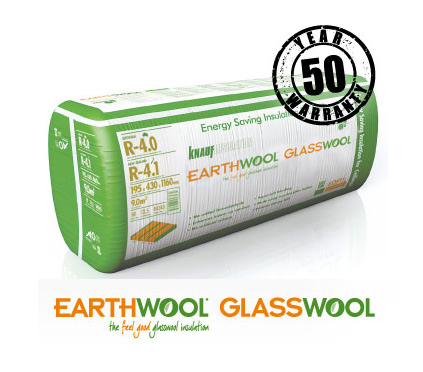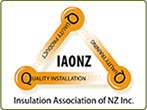 Earthwool glasswool insulation
Earthwool glasswool insulation
Earthwool glasswool is a high performance insulation product with combined energy saving, sound absorbing and fire resistance features. Made using recycled glass bottles and with ECOSE Technology, Earthwool glasswool doesn’t look or feel like any insulation you have ever experienced..
Earthwool glasswool is the pinnacle of Knauf Insulation’s range of insulation products, building upon years of testing and development focused entirely on the unique conditions of New Zealand. The Earthwool glasswool range, which includes Loft Rolls, Acoustic Rolls, DriTherm Cavity, Roof Slabs, Floor slabs (both thermal and acoustic), timber cladding and FrameTherm Rolls will be able to help enhance the energy efficiency, air quality and comfort level in any business or home in New Zealand.
Earthwool glasswool with ECOSE Technology
ECOSE Technology is a revolutionary binder based on rapidly renewable materials instead of petro-based chemicals. It reduces binder embodied energy and delivers superior environmental sustainability. It contains no added formaldehyde, bleaches or dyes… the brown colour of the insulation is completely natural.
Choosing the Right Earthwool glasswool Insulation Product
The extensive range of Knauf Insulation Earthwool glasswool products can seem overwhelming when choosing the right insulation for your home. There are a variety of products, categorised by their location within the home (roof insulation range, wall insulation range, and underfloor insulation range). These are then split by form (blankets, pads) and finally by thickness and R Rating (which indicated the thermal insulation property of the product). Choosing the right combination of projects for a home or business insulation project is important as small inaccuracies in installation (and product choice) can negatively affect the performance of the final installation.
Offering such a wide variety allows an exact finish on any project. Small inaccuracies in cover can have a major effect on the quality of insulation, with cracks and gaps allowing up to 50% of the impact of insulation to be lost. It is therefore vital to make sure that the right product is used in the right space to get maximum benefit. Expert fitters will be able to quickly select and install an exact fit, ensuring maximum energy savings for over 50 years.
The Earthwool glasswool Insulation Range includes a number of specialist products, including SteelTherm Rolls, Duct Roll and Pitched Roof Slab that will normally only be considered and installed by industry experts. These products, though easy to manipulate and install, do not usually appear in DIY projects or home installations. If required, it is usually best to consult and expert fitter to ensure that the product is suitable for the intended purpose. Each product throughout the Earthwool glasswool insulation range has readily available datasheets from the Knauf Insulation website. The main products are reviewed below.
Maximising Insulation Performance
In most homes, the majority of heat is lost through the ceilings and roof. Around 30-35% of all heat loss from the home is lost through the roof, which is why many project start (and often finish) here. Knauf Insulation’s loft insulation rolls, Loft Roll 40 & 44 (the numbers reflect the roll’s thermal conductivity) and Rafter Rolls vary in size, thickness and performance. The key with loft insulation is to use the largest single pieces available. The fewer joints and cracks between insulation pieces, the fewer the opportunities for heat to escape. Knauf Insulation Earthwool glasswool products do provide a good friction fit against frames, rafter and other rolls, but no fit can match the insulation properties of Earthwool glasswool itself.
Many insulating projects stop there. Having prevented 30% of heat loss from the home, there are noticeable reductions in heating. The Energy Efficiency & Conservation Authority (EECA) have shown that on average, 29% of a households entire energy bill is spent trying to heat the home, and a 30% saving on the heat lost via the roof and ceiling means that most houses will see a 5-10% reduction in annual energy bills by insulating the loft alone.
There are more opportunities. A further 25% of heat is lost via the walls. To combat this, Knauf Insulation have developed further products, each intricately designed for maximum performance in different circumstances. DriTherm Cavity Slabs are small insulation slabs, which knit together to form a solid, water repellent layer in cavity walls. Walls without cavities can still benefit from Earthwool glasswool insulation. The Earthwool glasswool RainScreen Slab is a semi-rigid, water repellent designed as a rainproof cladding for solid walls, offering protection from the elements on two fronts; temperature and rain. Finally, Timber Frame Party Wall Slabs provide New Zealand’s beautiful timber frame homes with both thermal and acoustic insulation for the ideal, cosy, peaceful home.
Finally, a further 12-14% of heat is lost through the floor. To combat this, Knauf Insulation Earthwool glasswool has developed both Soffit Linerboard and Acoustic Floor Slabs. Linerboards are veneered with a tough, weather resistant, puncture proof lining that protects the Earthwool glasswool insulation from the harshest of underfloor conditions, meaning that even in semi-exposed locations, the insulation is neat, aesthetic and high performance, with no degradation or performance loss from damage to the structure.
New Zealand Building Code Compliance
On choosing the correct product and size, there is one last decision to make. Each of the Knauf Insulation Earthwool glasswool products comes in a variety of thicknesses and R Ratings. R Ratings indicate the thermal insulation properties of a material, and it is not always a case of ‘bigger the better’. Though personal preference and available space will have an undoubted influence on the choice of R Rating and product selection, there are New Zealand building standards to consider. New Zealand is split into three zones. Each zone has its own climatic conditions and building standards for insulation and air quality.
Northland and the Coromandel are located in climatic Zone 1. Homes in zone one require slightly lower R Ratings than those of zones 2 & 3, as annual temperature fluctuations tend to be less severe than those of a further south. Zone 2 encompasses all of the North Island, apart from the Central Plateau, circling the coastal regions of the island from Auckland to the East Cape, Wellington to New Plymouth. The central plateau and the whole of the South Island make up Zone 3, which require higher R Ratings for many insulating areas, including roof, wall & skylight insulation.
Though with the right information, choosing the correct Knauf Insulation Earthwool glasswool products to insulate your home should be fairly straightforward, there are a number of insulating experts across the country that will easily, quickly and accurately be able to assist in both selecting the right product, and installing it flawlessly. The return on investment on hiring and insulating expert will be huge if you are in any doubt.
Acoustic Properties of Knauf Insulation Earthwool glasswool
Noise can be a major problem in many modern homes, whether it is trying to keep external noise out, or internally created noise in a specific corner, acoustic insulation is an easy win. Faced on one side with a durable, fire resistant laminate, Knauf Insulation Earthwool glasswool Acoustic Rolls provides both the thermally insulating properties of the Earthwool glasswool range but also have a huge effect on reducing ambient noise, keeping the peace at home.


